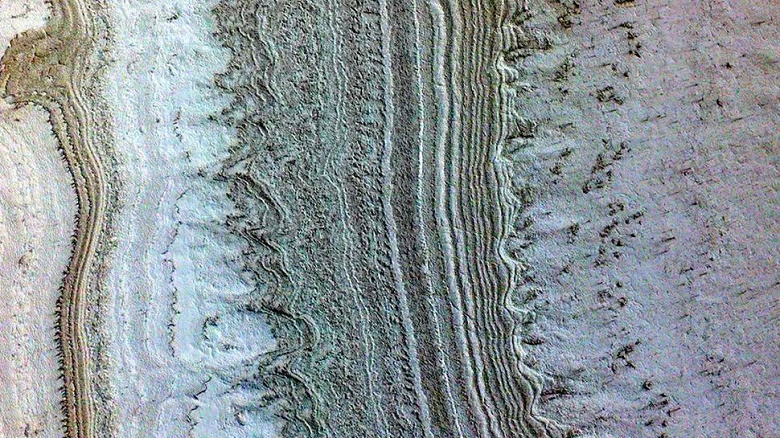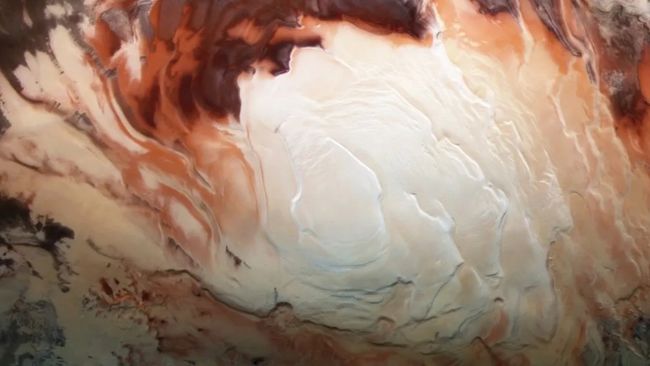Computer models show that densely packed layers of ice can mimic the radar signal from liquid water
New computer models have cast doubt on the existence of an underground lake of liquid water on Mars, discovered by the Mars Express orbiter. in 2018. Researchers at Cornell University have discovered that densely packed layers of ice can create radar reflections similar to those from liquid water.
In 2018, the MARSIS instrument on board the «Mars Express» discovered a lake-like object under 1.5 kilometers of ice in the south polar region of Mars. The discovery sparked interest because the presence of liquid water on the Red Planet may indicate potential habitability.
However, many scientists were skeptical about the find, demanding more conclusive evidence. Skeptics have pointed out that the surface of Mars is too cold and the atmospheric pressure is too low for liquid water to exist so close to the surface.
The presence of liquid water beneath Mars' southern polar cap would be possible if it were salty enough to lower its freezing point. One of the possible candidates for the role of «natural antifreeze» is calcium and magnesium perchlorate, which was discovered on the surface of Mars by NASA's Phoenix mission. in 2008.
However, researchers at Cornell University have hypothesized that radar reflections interpreted as a sign of liquid water may actually be caused by dense layers of ice. Modeling showed that under the influence of pressure and temperature, ice can behave plastically, forming layers with different densities. These layers can reflect radar signals in a way that mimics signals from liquid water.
Scientists continue to study this question, collecting more data and conducting additional simulations. Researchers plan to analyze the composition of the ice using other instruments on board Mars Express. and future Mars rovers. There are also plans to study the surface of the region where the lake was discovered, looking for additional geological evidence of liquid water.
«I can't say that it is impossible for liquid water to exist there, but we show that there are much simpler ways to get the same observations using mechanisms and materials that we already know exist& raquo;, — said Daniel Lalich of Cornell. Lalich is the lead author of the study, which suggests that compacted layers of ice can emit a strong radar signal, similar to the radar echo from a layer of liquid.

A large body of water is capable of reflecting radar back to its source, and on Earth, bright radar returns like the one detected by MARSIS almost certainly mean liquid water, similar to pockets of water beneath Antarctica, such as Lake Vostok. However, planetary scientists should be cautious in assuming that what is true for Earth is also true for other planets where conditions differ.
Lalich's team ran thousands of simulations to test whether several densely packed layers of ice could mimic a lake's radar signal. In each simulation, both the thickness of the ice layers and their composition varied. Scientists have discovered that in many cases, dense and ancient layers of ice can produce bright radar reflections similar to those detected by MARSIS.
The nuance lies in «constructive interference» radar waves. The spatial resolution of MARSIS is limited, and if the ice layers are too thin, the radar will not be able to distinguish them. Each layer will reflect part of the radar, and because the layers are pressed tightly together, the radar echoes overlap and combine, increasing their strength and making them appear stronger.
«This is the first time we have a hypothesis that explains the entirety of observations under the ice cap without introducing anything unique or strange. The result when we get bright reflections, — this is exactly what you would expect from thin-layer interference in radar», — said Lalich.
At the moment, the question of whether there is a salt lake under the south polar cap remains unanswered, but Lalich says modeling at least gives a much simpler and, in his opinion, more likely explanation than the lake.
«The idea of liquid water being even close to the surface would be truly exciting. I just don't think it's there», — said Lalich.

